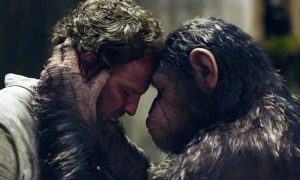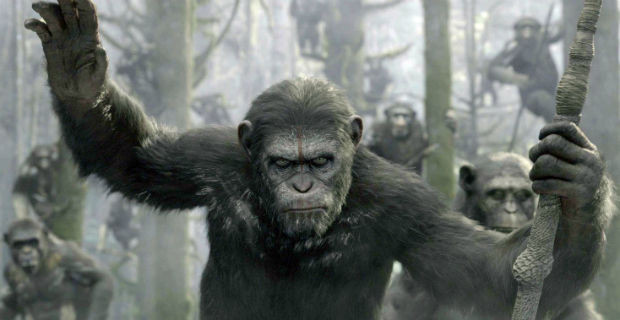Dawn of the Planet of the Apes is a film powered by anger. In every frame lurks a grimace, either human or simian, as a hint of danger to come. Director Matt Reeves delivers the danger and the fizz-boom-bah that comes with it; it shouldn’t be a problem for the director of Cloverfield. Whether he or his film delivers anything more than that is another matter.
By now, we have all but consigned Tim Burton’s visit to the Planet of the Apes to the dustbin of cinematic history, though the ending with Ape-raham Lincoln notably simultaneously insulted and mind-screwed the audience; a rare feat. Rupert Wyatt gave the dormant franchise the restart it deserved with Rise of the Planet of the Apes, at least if you can forgive the cardboard human characters and piss-poor dialogue. The coup was introducing us to Caesar, a triumphant blend of CGI and Andy Serkis’ remarkable animalistic performance. The ape became more human than the humans themselves. If Caesar didn’t work, the Planet would never have come to eloquently sonorous life. Following the success with Caesar, Dawn… builds on the foundations of Rise… This time we get more apes, more guns and more complex humans. Well, two out of three ain’t bad.
The darkening of tone is set out in the opening, which charts the spread of the Simian Flu from the conclusion of Rise… From above the Earth we view the virus spreading and the lights of the human world slowly fade out. So far, so zombie-movie. As mankind is crippled, the apes are making leaps and bounds of all kinds: physical, governmental, grammatical. Indeed, most scenes of apes interacting come with subtitles as they communicate via sign language. This grounding of the apes and their society elevated Rise… above simian schlock, and it will do the same for Dawn…
 From James Franco’s benevolent scientist in the first installment, we jump ten years ahead to Jason Clarke’s benevolent… well, benevolence. Evidently the residents of the overgrown commune that used to be San Francisco pre-Simian Flu are less defined by their occupations than by their star power. Of the humans, Gary Oldman is most memorable as Dreyfus, the leader of this new order of Franciscans. He can bellow out a speech with the best of them, but the calm charisma of Caesar cannot be beat. He leads his own troop of intelligent apes, now resident in the Muir Woods beyond the Golden Gate Bridge. The realisation of the apes is truly special. Their faces carry so much; the samey nature of Roddy McDowall’s stiff make-up is replaced by identifiable emotion, courtesy of the wizards at Weta. Serkis commands the screen from behind the pixels, though he does have plenty of support in his fellow chimps. Not least of these is Toby Kebbell as Koba, the snarling former lab monkey who virulently distrusts homo sapiens. His raging yang to Serkis’ dignified yin makes for a formidable power play, and is easily the most interesting relationship in the film. Clarke’s Malcolm is gifted a wife (Keri Russell) and son (Kodi Smit-McPhee), but stinky humans are no match for mighty ape in this script. With the exception of Kirk Acevedo’s Carver, who is just an ape-hating grunt, the humans here aren’t all stereotypes. They’re just a bit boring. This isn’t necessarily the fault of Clarke, Russell et al. Reeves and the script are clearly more interested in the apes. Fair enough; after all, they are the ones on the cusp of becoming a civilisation.
From James Franco’s benevolent scientist in the first installment, we jump ten years ahead to Jason Clarke’s benevolent… well, benevolence. Evidently the residents of the overgrown commune that used to be San Francisco pre-Simian Flu are less defined by their occupations than by their star power. Of the humans, Gary Oldman is most memorable as Dreyfus, the leader of this new order of Franciscans. He can bellow out a speech with the best of them, but the calm charisma of Caesar cannot be beat. He leads his own troop of intelligent apes, now resident in the Muir Woods beyond the Golden Gate Bridge. The realisation of the apes is truly special. Their faces carry so much; the samey nature of Roddy McDowall’s stiff make-up is replaced by identifiable emotion, courtesy of the wizards at Weta. Serkis commands the screen from behind the pixels, though he does have plenty of support in his fellow chimps. Not least of these is Toby Kebbell as Koba, the snarling former lab monkey who virulently distrusts homo sapiens. His raging yang to Serkis’ dignified yin makes for a formidable power play, and is easily the most interesting relationship in the film. Clarke’s Malcolm is gifted a wife (Keri Russell) and son (Kodi Smit-McPhee), but stinky humans are no match for mighty ape in this script. With the exception of Kirk Acevedo’s Carver, who is just an ape-hating grunt, the humans here aren’t all stereotypes. They’re just a bit boring. This isn’t necessarily the fault of Clarke, Russell et al. Reeves and the script are clearly more interested in the apes. Fair enough; after all, they are the ones on the cusp of becoming a civilisation.
As the humans become desperate for electricity, a hydroelectric dam in ape territory is the MacGuffin for the evening. Caesar wants to give the humans access to placate them; Koba wants them out. It sounds like a simplistic dichotomy of characters, but the humans fare little better. While Malcolm seeks access to the dam, Dreyfus is assembling weapons in case the apes cross the bridge. His fear is understandable. An early human excursion into the ape’s territory ends badly, and sees the apes assemble in San Fran en masse to warn the humans to stay put. There is something so simply off-putting about the image of an ape on horseback that you daren’t argue. Reeves boasts an eye for such riveting imagery, and it serves him particularly well in the action scenes. The highlight is a street battle between Dreyfus’ men and Koba’s newly-armed simian soldiers attempting to seize the city with all guns blazing. The whole rout looks like Charlton Heston’s Kafka dream, with Kebbel’s snarling, scarred Koba lit up by incendiaries and blood thirst. He’s frankly terrifying.
After the apes gain the upper hand, the plot mechanics become all too visible. The tower block where the humans reside becomes a fitting setting for an ape-on-ape showdown in the final act. Not surprising, but then the scripts were never the stars of the Apes franchise. The effects seal the deal, and even since Rise… they’ve noticeably improved. There’s scope for this franchise to continue, though on this evidence the final gut-punch of 1968’s original will never be eclipsed. Revel in the above-average summer fare that Dawn of the Planet of the Apes clearly is, and just hope for more.

